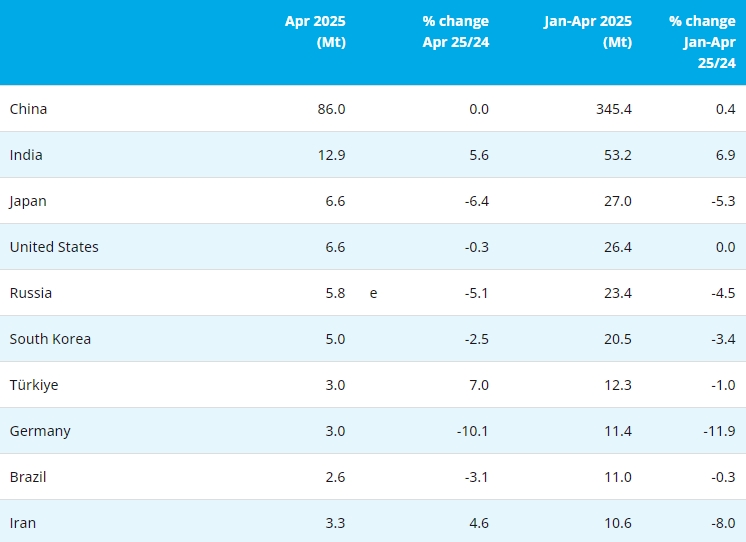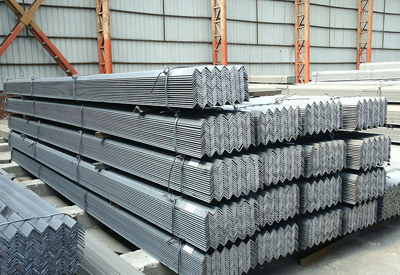With the industrialization of the world, the demand for steel and the output of steel-making are increasing year by year. From 2015 to 2019, the global crude steel output will increase from 1.589 billion tons to 1.849 billion tons, and China will become the largest country in the world, with the national crude steel output reaching 990 million tons in 2019.
Hebei is the largest steel output province in China. In 2019, the crude steel output will reach 240 million tons, accounting for nearly one fourth of China's crude steel output and one eighth of the world's.
We can compare the Hebei’s crude steel output with other provinces to make Hebei stand out. Jiangsu Province is closely followed by Liaoning Province with 120 million tons of crude steel output. Liaoning Province ranks third with only 73 million tons of crude steel output. That is to say, the crude steel output of Hebei Province is more than that of the combination of the second and the third largest provinces.
Then, we can also compare the Hebei’s crude steel output with the world's crude steel output: India, the world's second largest crude steel producer, producing 110 million tons of crude steel in 2019, Japan, the third largest producer, producing 99 million tons of crude steel, followed by the United States, producing less than 88 million tons. The crude steel output of these three countries is only 300 million tons, less than a quarter that of Hebei.
Finally, we can conclude that Hebei is the world's largest iron and steel Province. Why can Hebei province produce 240 million tons of crude steel and become the world's largest iron and steel province?
1 Rich mineral resources
Iron and steel smelting is inseparable from mineral resources, and Hebei is rich in mineral resources, especially iron ore and coal resources.
It is reported that in 2017, the iron ore reserves in Hebei Province were 9.516 billion tons, accounting for 13.22% of the total iron ore in China, ranking third among many provinces in China; in the past decade, the iron ore output of Hebei Province ranked first for 12 consecutive years.
Today, more than 130 kinds of minerals have been found in Hebei, with 1503 mineral producing areas. It is precisely because of such rich mineral resources that so many steel-making enterprises in Hebei can be supplied and steel can be continuously produced, which is the foundation for Hebei to become the world's largest steel province.
2. There are a large number of steel-making enterprises
Most of the iron and steel enterprises in Hebei Province are located in Tangshan and Handan. The crude steel output in Tangshan is more than that in Handan. In 2019, the output was 136 million tons, accounting for nearly 60% of the total crude steel output of Hebei Province. Although Handan only accounted for 20% of the total crude steel output, it can not be underestimated in other provinces of the country.
However, today's iron and steel enterprises in Hebei are dominated by private enterprises. In 2018, 180 million tons of crude steel were produced, more than three-quarters of the province's crude steel output, and the main business income reached more than 990 billion yuan, more than four fifths of the province's steel income.
3. There is a large demand in the local market
Hebei is close to the Beijing, the capital city in China, and its economic development is relatively faster compared with other remote provinces, which means that there requires urban infrastructure improvement, and steel is an indispensable raw material, so the demand for steel in the local market is huge.
Now Hebei’s urbanization rate is less than 60%, which is lower than the national level in the same period. This means that if we speed up urbanization, then the demand for raw materials such as steel will also increase.
4. Convenient and low-cost transportation
As early as 2017, the railway mileage in Hebei Province has reached more than 7200 kilometers, 383 kilometers per 10000 square kilometers, which has reached the national level in the same period. That is to say, the railway density in Hebei Province is higher than that in other provinces in the country.
In addition, there are two special coal transportation lines from Shanxi to Hebei, namely Datong to Qinhuangdao and Shenchi to Huanghua. They can quickly transport coal from Shanxi to Hebei, saving time and economic costs, which is also a major advantage of Hebei Iron and steel enterprises.
Of course, the highway transportation in Hebei also plays an important role. The mileage of highways is nearly 200000 kilometers, including more than 7000 kilometers of high-speed highways, which also ranks the second in China.
The delivery via water is also favorable in Hebei. It has three major coastal ports, namely Qinhuangdao port, Huanghua port and Tangshan port. The annual cargo throughput of the three major ports can reach 1.1 billion tons, more than 10% of the total cargo throughput of coastal ports in China, ranking the fourth in China.
In a word, the reason why Hebei Province can become the largest iron and steel Province in the world is that it is closely related to its mineral resources with numerous steel-making enterprises and talents, large market demand, and low transportation cost. The combination of these advantages will provide Hebei more potential to develop iron and steel enterprises, and the crude steel output will lead other provinces and even the world.
- [Editor:Catherine Ren]



 Save
Save Print
Print Daily News
Daily News Research
Research Magazine
Magazine Company Database
Company Database Customized Database
Customized Database Conferences
Conferences Advertisement
Advertisement Trade
Trade




 Online inquiry
Online inquiry Contact
Contact

Tell Us What You Think